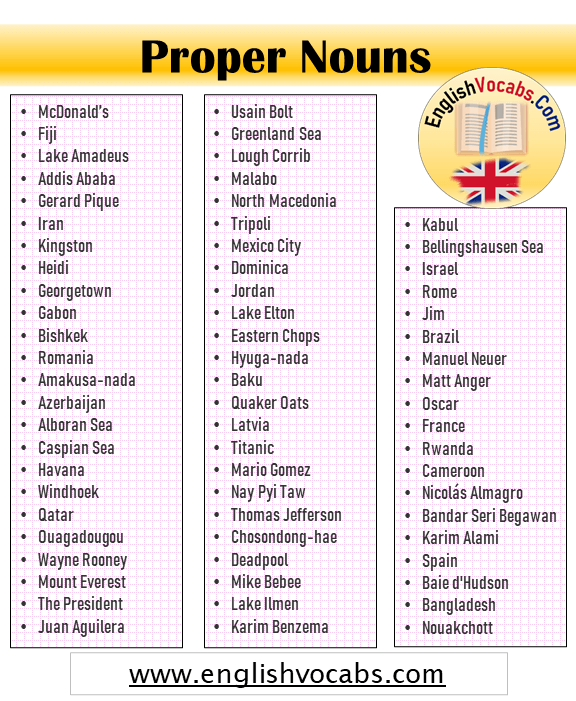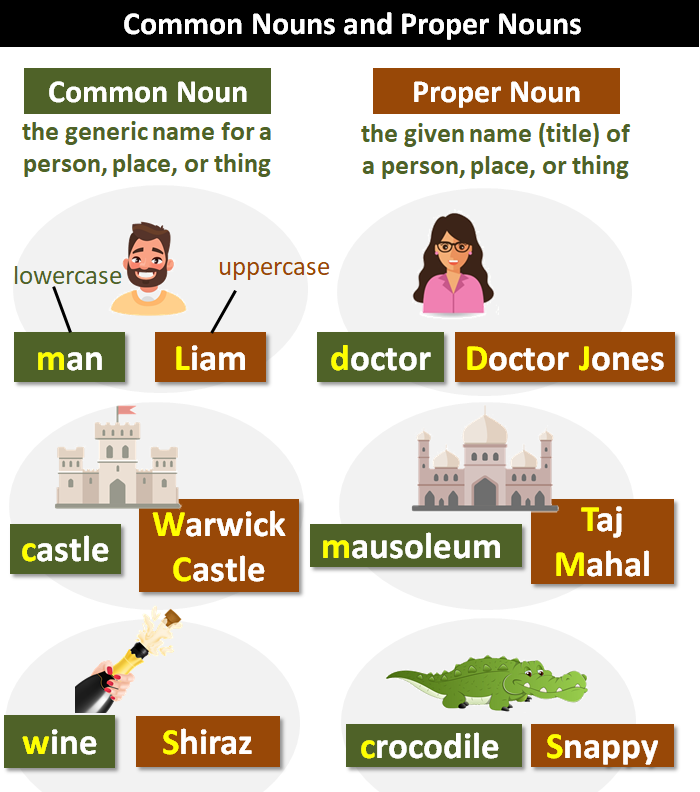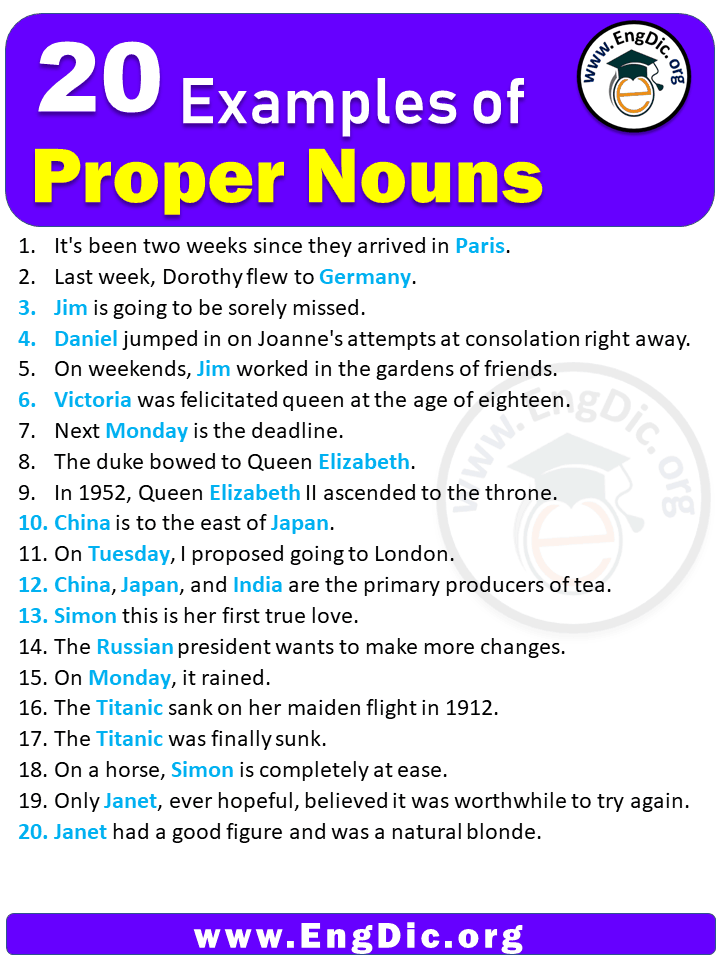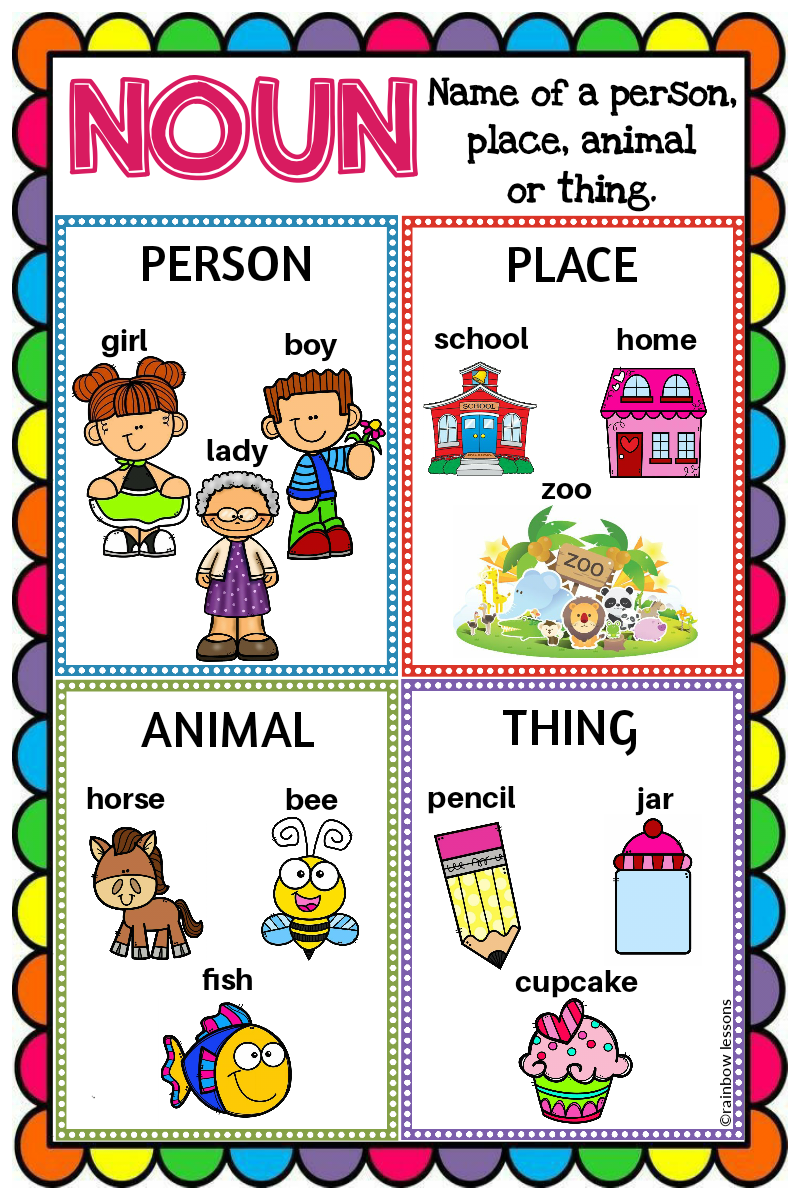
50 proper nouns, Definition and Examples English Grammar Here
10 examples of proper noun 1. Human noun: John, Carry, Todd, Jenica, Melissa etc. 2. Institution, establishment, institution, authority, university nouns: Saint John High School, Health Association, British Language Institute, Oxford University, New York Governorship etc. Advertisements 3.

Image result for proper noun Proper nouns, Proper noun examples, Nouns worksheet
The Oxford Learner's Dictionary defines proper nouns as 'a word that is the name of a person, a place, an institution, etc'. According to the Merriam-Webster Dictionary, a proper noun is 'a word or group of words (such as "Noah Webster," "Kentucky," or "U.S. Congress") that is the name of a particular person, place, or thing and that usually begins with a capital letter'.

5 examples of proper nouns English Vocabs
What to Know A proper noun names a particular person, place, or thing. Some proper nouns are: Noah Webster, North America, and The Statue of Liberty. A common noun refers to a person, place, or thing (also to a quality, idea, or action), but it doesn't name it. Some common nouns are: writer, continent, and statue.

Proper Noun Definition, Examples, List & Sentences in 2021 Good vocabulary words, Proper
Start writing with Ginger Remember that all nouns are words naming people, animals, places, things, and ideas. Every noun can be further classified as either common or proper. The distinction is very easy to make once you see some examples and come up with a few of your own. Proper Noun Examples

20 Proper Nouns List Examples English Vocabs
A proper noun is the name given to something (e.g., "Jonathan," "Ollie," "New York," "Monday"). Proper nouns are written with capital letters regardless of where they appear in a sentence. Proper nouns contrast with common nouns, which are the words for things (e.g., "boy," "dog," "city," "day"). Common nouns are written with a capital letter.

20 examples of proper noun in english English Grammar Here
Home Knowledge Base Nouns and pronouns What Is a Proper Noun? | Definition & Examples What Is a Proper Noun? | Definition & Examples Published on August 18, 2022 by Jack Caulfield . Revised on January 23, 2023. A proper noun is a noun that serves as the name for a specific place, person, or thing.

Proper Nouns Explanation and Examples
Last Updated On: March 1, 2022 Do you get confused about the difference between a common noun and a proper noun? Would practice help you become a master? Read on to learn about the difference between common and proper nouns, how they are used, and when to use them.

Examples of Proper Nouns (35 Sentences) EnglishGrammarSoft
Firstly, grammar rules dictate that a proper noun should always get used with the first letter capitalized. An exception is certain cases when the noun acts as a common noun instead of a proper noun. The second important rule determines when a proper noun can be used with the word "the.". Typically, the word "the" can only be used in.

Proper Nouns ExamPlanning
Examples from our community 10000+ results for 'common and proper nouns with pictures' Anna's Quiz on Common, Proper, and Collective Nouns Quiz by Tapowell60 nouns common proper collective Common and Proper Nouns Open the box by Dorvalm G3 English Common and proper nouns Quiz Quiz by Ramblin12 Common and Proper Nouns Group sort by Harrisoc

100+ List of Proper Noun in English »
Capital Letters with Proper Nouns. RULE: We always use a Capital Letter for the first letter of a name or proper noun. This includes names of people, places, companies, days of the week and months.For example: They like Anthony.(not They like anthony.)I live in England.; She works for Sony.; The last day in January is a Monday.; We saw Titanic in the Odeon Cinema.

Proper Noun Wonderful List Of 100+ Proper Nouns In English Love English
What is this proper nouns poster? This handy poster gives many different examples of proper nouns, helping children understand what a proper noun is, and how it's used. This can help with writing, showing children what should be capitalized. Also great for enhancing your classroom and general display! Show more Related Searches

Proper Noun Definition, Rules and Examples of Proper Nouns Efortless English
In some cases, a proper noun can be used as a common noun, indicating that more than one person or thing shares the same name. The proper noun retains its capitalization but might be accompanied by verbiage typically used with common nouns (e.g., it may be pluralized or used with adjectives, articles, or determiners like a common noun would be).

20 Examples of Proper Nouns in Sentences EngDic
Proper nouns name specific people, places, things, or ideas. While every proper noun has a corresponding common noun, not every common noun has a corresponding proper noun. Common nouns and proper nouns can do many things in sentences. They can be subjects, objects, predicate nouns, and more. Sentence diagramming is fun and helps us see what.

Common and Proper Noun Bundle Made By Teachers
Proper nouns vs. common nouns Proper noun examples. The following sentences incorporate examples of proper nouns: People. Leonardo da Vinci created some of the art world's most famous paintings.. Steve couldn't believe Ronald Reagan was an actor before becoming president.. Michael J. Fox is well known for his role in Back to the Future.. Places

NOUNS What is a Noun? Useful Rules, List & Examples Beauty of the world
Examples include England, Santiago, South Street Seaport, and Ebbets Field. 4. Calendar days: In English grammar, months and days of the week are proper nouns, like September and Thursday. Although the months of the year are proper nouns, the seasons are not and are thus not capitalized.

Proper Noun (video lessons, examples, explanations)
Consider the following examples: "I am going to the store with my mother." "Would you like to go to the store with me, Mother?" In the first instance, you are using the term in a general way, though it's pretty clear you're speaking of your mother.